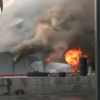Greenland Ice Melt Surged 17 Times Faster During Historic May Heatwave, Raising Global Alarm
In a stark warning from climate scientists, Greenland’s ice sheet melted at a rate 17 times faster than normal during a historic heatwave last month, according to a new report by the World Weather Attribution group. The extreme heat, driven by global warming, hit parts of Iceland and Greenland with record-breaking temperatures, triggering unprecedented environmental consequences.
The report, which focused on the seven hottest days in Iceland and the single hottest day in eastern Greenland, highlights the dire risks of extreme heat in polar regions that are typically accustomed to long, harsh winters. Researchers warned that such rapid ice melt could accelerate sea-level rise, disrupt global ocean currents, and trigger cascading effects on ecosystems and weather patterns worldwide.
Record Temperatures in Iceland and Greenland
Egilsstadir Airport in eastern Iceland recorded a temperature of 26.6°C in May—marking the highest-ever temperature for the month in the region’s history. Similarly, the Ittoqqortoormiit station in eastern Greenland registered a shocking 14.3°C on May 19, which is approximately 13 degrees above the region’s average for that time of year.
Such anomalies are not just statistical curiosities—they are climate red flags.
“This heatwave arrived earlier and lasted longer than similar events in the past,” the report noted, attributing the unusual spike in temperatures to a combination of weather systems. A high-pressure system near the Faroe Islands and a low-pressure system south of Greenland’s Cape Farewell generated a flow of warm air from the south, driving temperatures to unseasonal highs.
Catastrophic Chain Reactions
Melting at such a high rate could have a wide-reaching impact. The Greenland ice sheet contains enough frozen water to raise global sea levels by over seven meters. A sudden spike in meltwater, as observed in May, can accelerate this process, leading to widespread coastal flooding and damage to low-lying cities across the globe.
Additionally, the heat can significantly damage infrastructure within the Arctic region itself. Roads, buildings, and communication lines in Iceland and Greenland are often not built to withstand such thermal stress. The melting permafrost and shifting foundations pose real dangers to local communities.
Impact on Local Ecosystems and Livelihoods
Beyond infrastructure, the melt affects food security for Arctic communities. Warmer waters and disrupted ecosystems are already forcing cold-water fish such as halibut and species like shrimp to migrate further north, making them less accessible to local fishers.
“Hunting, fishing, and even seasonal travel depend on stable ice conditions. When the ice breaks early or unpredictably, it directly threatens the livelihoods and cultural traditions of Indigenous and local populations,” the report stated.
Global Implications
Perhaps most alarmingly, such extreme Arctic events serve as feedback loops that reinforce global warming. The loss of reflective ice cover accelerates heat absorption by darker ocean waters—a phenomenon known as the albedo effect—which in turn raises temperatures further.
As the planet continues to warm, the frequency and severity of such events are expected to rise. The World Weather Attribution scientists concluded that urgent global climate action is required to limit emissions and prevent irreversible changes to the Earth’s climate system.
IT.




























